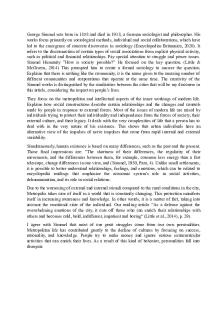Learning Journal Unit 4 PDF

| Title | Learning Journal Unit 4 |
|---|---|
| Author | Liz Be |
| Course | Macroeconomics |
| Institution | University of the People |
| Pages | 2 |
| File Size | 83.7 KB |
| File Type | |
| Total Downloads | 16 |
| Total Views | 148 |
Summary
Download Learning Journal Unit 4 PDF
Description
Learning Journal Unit 4 I choose the following questions from chapter 11 1. Here are annual values for M2 and for nominal GDP (all figures are in billions of dollars) for the mid-1990s. Year M2
Nominal GDP
1993
3,482.0
$6,657.4
1994
3,498.1
7,072.2
1995
3,642.1
7,397.7
1996
3,820.5
7,816.9
1997
4,034.1
8,304.3
a. Compute the velocity for each year. V= PV M 1993 V = $6,657.4 / 3,482.0 = 1.92 1994 V = $7,072.2/3,498.1 = 1.62 1995 V = $7,397.7/3,642.1 = 2.03 1996 V = $7,816.9/3,820.5 = 2.05 1997 V = $8,304.3/4,034.1 = 2.06 b. Compute the fraction of nominal GDP that was being held as money. Fraction held as money for each year 1993 = 1/1.92 = 0.52 1994 = 1/1.62 = 0.62 1995 = 1/2.03 = 0.49 1996 = 1/2.05 = 0.488 1997 = 1/2.06 = 0.485 c. What is your conclusion about the stability of velocity in this five-year period? I think that, velocity is not that stable because it falls and later on increases in various years. Also, looking at Velocity (A) and fraction of nominal GDP (B) the money held remains stable across the years and as the same time, the money declines over time. This shows that, money is frequently used and not held in the economy. 2. Here are annual values for M2 and for nominal GDP (all figures are in billions of dollars) for the mid-2000s. Year
M2
Nominal GDP
2003
6,055.5
$10,960.8
2004
6,400.7
11,685.9
2005
6,659.7
12,421.9
2006
7,012.3
13,178.4
2007
7,404.3
13,807.5
a. Compute the velocity for each year. V= PV M 2003 = $10,960.8/6,055.5 = 1.810 2004 = $11,685.9/6,400.7 = 1.826 2005 = $12,421.9/6,659.7 = 1.865 2006 = $13,178.4/7,012.3 = 1.879 2007 = $13,807.5/7,404.3 = 1.865 b. Compute the fraction of nominal GDP that was being held as money. Fraction held as money for each year 2003 = 1/1.810 = 0.552 2004 = 1/1.826 = 0.548 2005 = 1/1.865 = 0.536 2006 = 1/1.879 = 0.532 2007 = 1/1.865 = 0.536 c. What is your conclusion about the stability of velocity in this five-year period? We can see that, velocity and Fraction of GDP held as money remains stable across the years. 9. Explain what is meant by the statement that people are holding more money than they want to hold. I think the statement means that, people are holding more money than they want to hold is so that they can purchase goods and services they require everyday like buying lunch, groceries, paying rent, electricity, bus fare and other significant needs. People need to make home repairs, pay for health care needs, and they do not know when the need may arise that is why they prepare for them by holding money so that they will have it available when the need arises. Also, people can hold money for transactions demand, precautionary demand and speculative demand (Rittenberg. L. & Tregarthen. T. 2012). Reference Rittenberg. L & Tregarthen. T, 2012). Macroeconomics Principles v.2.0 textbook. Retrieved fromhttps://my.uopeople.edu/pluginfile.php/136135/mod_resource/content/1/TEXT %20macroeconomics-principles-v2.0.pdf...
Similar Free PDFs

Learning journal unit 4
- 3 Pages

Learning Journal Unit 4
- 2 Pages

Learning Journal Unit 4
- 1 Pages

Learning journal unit-4
- 2 Pages

Learning Journal Unit 4
- 1 Pages

Learning Journal Unit 1
- 2 Pages

Learning Journal Unit 8
- 2 Pages

Learning Journal Unit 3
- 2 Pages

Learning journal unit 3
- 2 Pages

Learning Journal unit 7
- 2 Pages

Learning Journal Unit 8
- 2 Pages

Learning Journal Unit 6
- 1 Pages

UNIT 3 Learning Journal
- 2 Pages

Learning Journal Unit 2
- 2 Pages

Learning Journal. Unit 6
- 3 Pages
Popular Institutions
- Tinajero National High School - Annex
- Politeknik Caltex Riau
- Yokohama City University
- SGT University
- University of Al-Qadisiyah
- Divine Word College of Vigan
- Techniek College Rotterdam
- Universidade de Santiago
- Universiti Teknologi MARA Cawangan Johor Kampus Pasir Gudang
- Poltekkes Kemenkes Yogyakarta
- Baguio City National High School
- Colegio san marcos
- preparatoria uno
- Centro de Bachillerato Tecnológico Industrial y de Servicios No. 107
- Dalian Maritime University
- Quang Trung Secondary School
- Colegio Tecnológico en Informática
- Corporación Regional de Educación Superior
- Grupo CEDVA
- Dar Al Uloom University
- Centro de Estudios Preuniversitarios de la Universidad Nacional de Ingeniería
- 上智大学
- Aakash International School, Nuna Majara
- San Felipe Neri Catholic School
- Kang Chiao International School - New Taipei City
- Misamis Occidental National High School
- Institución Educativa Escuela Normal Juan Ladrilleros
- Kolehiyo ng Pantukan
- Batanes State College
- Instituto Continental
- Sekolah Menengah Kejuruan Kesehatan Kaltara (Tarakan)
- Colegio de La Inmaculada Concepcion - Cebu
